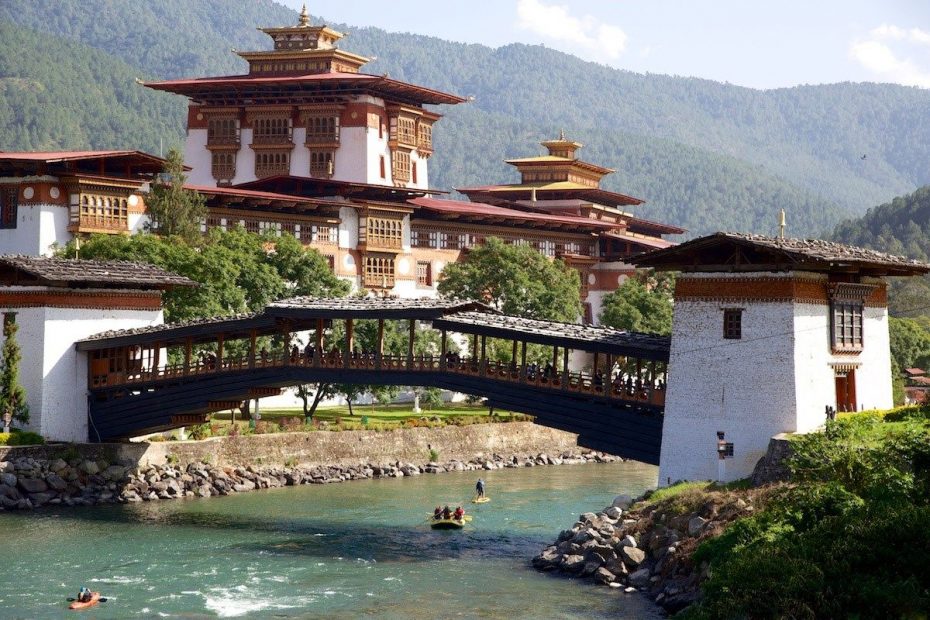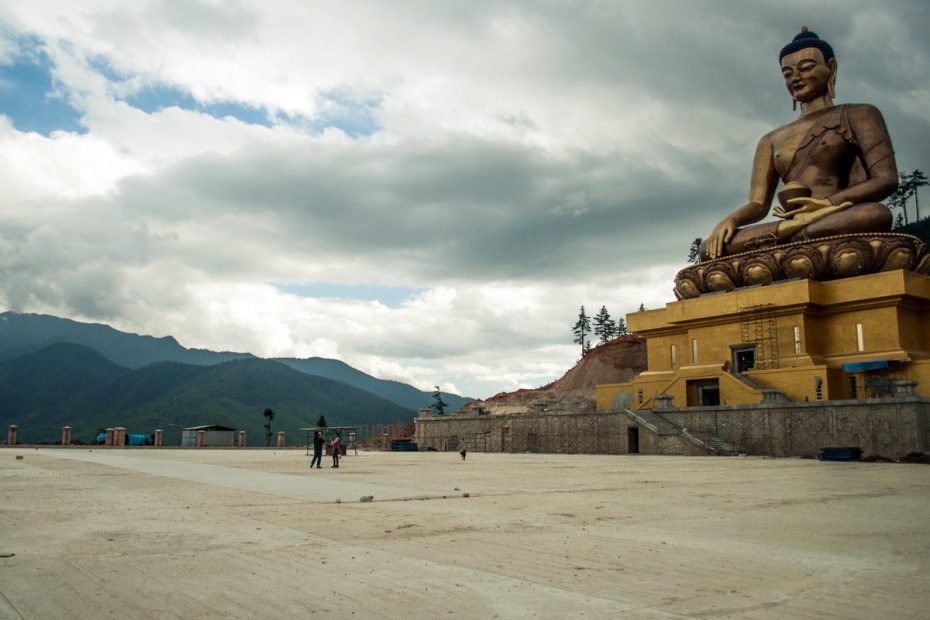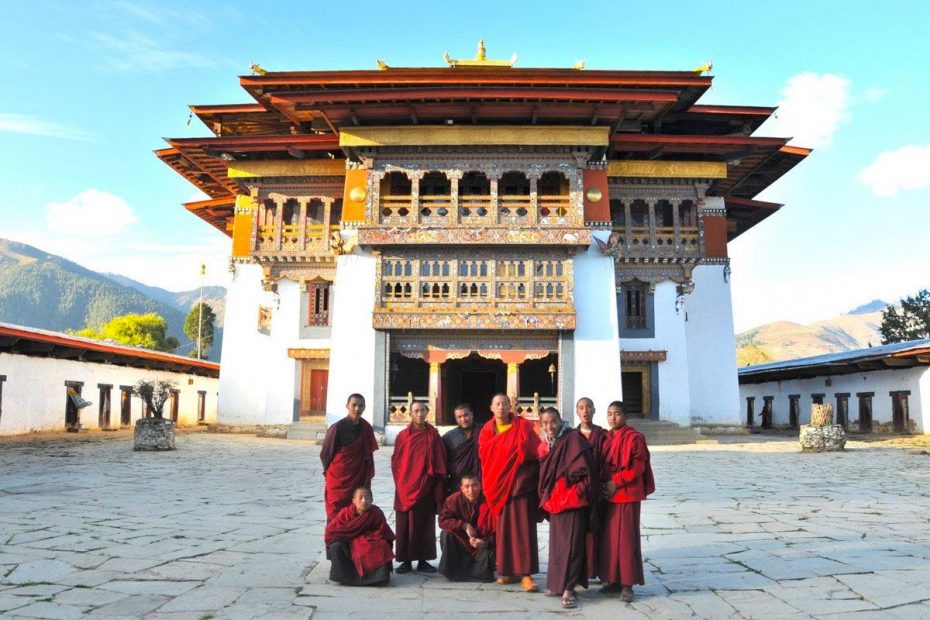Best of Bhutan: wildlife, communities, and trekking
14 Days
This itinerary is thought as to experience and visit the holy sites of Bhutan that were blessed by Guru Rinpoche during his long journey from India to Tibet in the 8th Century CE and also to get to explore the cultural and ecological richness of Bhutan. Bhutan, unlike its other Himalayan neighbours, considers all creation sacred, including trees, mountains, rivers, and lakes. Consequently, Himalayan species near extinction in the bordering countries of Nepal, India, and Tibet are doing well in Bhutan. Bhutan is also the last bastion of vajrayana Buddhism, a spiritual practice that is known to be one of the most profound schools of teaching in the Buddhist world. The sacred monasteries, the fluttering prayer flags that line the high ridges, the red robed monks chanting their prayers — all give this kingdom an aura of another time.
This is BHUTAN: Known to its inhabitants as Druk Yul — “the Land of the Thunder Dragon. The culture remains vibrant and the environment pristine as Bhutan continues to thrive in the 21st-century. Apart from the majesty and grandeur of the natural surroundings, the environment allows communion with the divine through meditation and contemplation. Bhutan is an abode of Buddhist deities, immortals, and saints in the Himalayas. Scholars wandering yogis, saints and lay pilgrims, have been irresistibly drawn to these remote and rugged mountains throughout the centuries in their search for wisdom and inspiration. Experience the landscapes they have blessed for all pilgrims by following in their footsteps. As you travel to these hidden holy shrines and otherworldly ancient monasteries (Gompas), hiking through an unspoiled Himalayan environment, you will rediscover this peace and solitude.
The scared Paro Taktshang, Tiger Nest is blessed during 7th century, by the great tantric master, Guru Rinpoche, who came here by his miraculous, flying on the back of flaming tigress in form of Guru Dorje Drolo from Khenpajong (eastern Bhutan) on the way from Tibet, to advocate the Buddhism teaching in Mon-Yul (place of darkness). Here, he meditated almost three months and blessed with numerous of Neys (holy site), subdued and activated the evil deities as Buddhism protectors and even the whole locality was also turned into Buddhist. From Pemayangtse monastery, meaning perfect sublime lotus, the beautiful Khachopelri monastery, the unique Bon Monastery of Kewzing and finally to the famous, majestic Tiger’s Nest (Taktsang) balanced among the clouds high above Paro, blessed by Guru Padmasambhava himself, this journey provides a true insight to the rich culture and religiousness of Bhutan.



JOURNEY OVERVIEW AND PROGRAM DETAILS
1° DAY: ARRIVAL IN KOLKATA
Kolkata
Arrival at Calcutta international airport. Transfer to hotel for refreshing and rest. Kolkata, formerly Calcutta, is the capital of the Indian state of West Bengal. Located on the east bank of the Hooghly river, it is the principal commercial, cultural, and educational centre of East India, while the Port of Kolkata is India’s oldest operating port as well as its sole major riverine port. As the former capital of British India, Kolkata retains a feast of colonial-era architecture contrasting starkly with urban slums and dynamic new-town suburbs with their air-conditioned shopping malls. Afternoon short city tour which also includes a country boat ride on the Ganges to experience the glorious sun set.
Overnight in Kolkata (B)
2° Day: SAFARI IN GORUMARA PARK
Kolkata – Bagdogra – Dooars
Early morning flight to Bagdogra. On arrival transfer to a forest resort in Dooars. (around 2 hours). Refreshments will be served upon arrival. Check-in to the room, followed by Lunch. Later Embark on an afternoon jungle safari in Gorumara National Park to view some of the wildlife inhabiting the region – one-horned Indian Rhino, Elephant, Gaur (Indian Bison) as well as a variety of endemic and migratory birds. After the jungle safari reurn to the hotel for dinner.
Overnight in Doars (B/L/D)
3° Day: TRANSFER TO BHUTAN
Doars – Punshotling – Thimpu
After an early breakfast drive to Phuentsholing, the Gateway to Bhutan from India, pass by terraced fields and tea gardens. Here you can purchase souvenirs of their visit from local shop. You can try some local delicacies for lunch in Phuentsholing. Here our Bhutanese guide will meet you. Travel to Thimpu (167 km about 4,30 hrs). Leaving the city of Phuentsholing you will heading towards cool and clean air, the road climbs to a higher elevation as you will experience the thin air of the high Himalaya, drive pass Kharbandi Gomba, overlooking the border town of Jaigon and Puntsholing. In a couple of hours drive you will reach Chhukha. There you will see hydro projects, which generates 1020MW of electricity by the Wang Chhu River. You will come across the immigration check point before you climb the Chapcha Village. After crossing the pass, the road drops quickly and follows the upper Wangchhu river, after which your drive becomes much comfortable road till Thimpu. Check in the hotel and rest. If more time later you can visit the tallest budhha Statue in Kusen phodrang hill.
Overnight in Thimpu (B/L/D)
4° Day: EXPLORE THIMPU
Thimphu
After breakfast you will start the day by visiting the National memorial chorten (shrine) a monument dedicated to the 3rd king and also a visit to tallest budhha at kuensel phodrang . Afterwards Visit Traditional Painting School, a school for Bhutan’s 13 traditional Arts and crafts, stops at Traditional handmade paper from Daphne plant. It is worth a visit to get to know the living national art of weaving. Afternoon, take a short drive to upper Thimphu valley to see our national animal Takin.
You will take a short drive to Choki art and craft center in Kabisa and also a small visit to Vast. After that you can stroll around the street of Thimphu by your own or have a relaxed evening tea at your hotel
Overnight in Thimpu (B/L/D)
5° Day: MONASTERY VISIT PHOBJIKHA
Thimphu – Phobjikha
Right after breakfast drive towards Phobjikha, after 18 km you will be on druk wangyal 108 chorten at douchula pass. The pass offers a stunning 360° panaromic view of mountain ranges. Drive through the pelela pass to Phobjikha. Arrive and lunch.
Late afternoon a visit to gangtey gompa. The Gangtey Monastery or the Gangtey Goempa is an important monastery / temple associate with the Nyingmapa school of Buddhism. The monastery was established in 1613 by Peling Gyalse Rinpoche, the grandson of Trenton Pema Lingpa the great treasurer discoverer. Join the Monks in offering ceremony. Phobjikha is a quite glacial valley. Phobjikha valley is the winter home of the rare Black Necked Cranes that migrate from Tibet from the arid plains of Tibet to roost in the more comfortable climate of the Phobjikha Valley. The valley is at an altitude of 2900 meters above sea level and experiences a much lighter winter as compared to the harsh extremes of Tibet. You can relax here and have a good walk in the scatter village with their lush vegetation. If you book in advance in the evening, you can experience a traditional hot stone bath (not included).
Overnight in Phobjikha (B/L/D)
6° Day: DRIVE TO TRONGSA
Phubjikaha – Tronsga
Today after breakfast, before driving to Trongsa visit the Bayta community school and spend some time with the children here. Later drive towards Tronsga. It’s a beautiful drive through lush vegetation and small beautiful village. Enjoy the Breath taking view of Chendebji and Rukubji Village. Check in the Hotel. Late afternoon visit the Majestic Trongsa Dzong and if time permit the Museum just above the Dzong.
Overnight in Tronsga (B/L/D).
7° Day; EXPERIENCE NABJI RURAL LIFESTILE
Trongsa – Nabji
Morning after breakfast drive to Nabji (around 2 hours), a small village where you can immerse yourself in the daily lives and farming chores of the local community while helping them to conserve environment as well as their cultural and historical heritage. Your travel to such village will give rural communities additional source of income to supplement their live hood from subsistence farming . You will be able to practice Budhism here in this village. In the 8th century Guru Rimpoche came to Bhutan as a mediator between the warring lingks, King sindhu raja of the bumthnag and King nangxchen (big nose) of upper Assam. The peace pact pillar is found in nabji lhakhag 9 temple), the name of the village Nabji is derived from the word Nabbi meaning “ to promise “. You will have the chance to join the villagers in their daily farming activity. This tiny village is located amid Jigme Singey Wangchuk National Park and people live mostly out of farming. Visit a farm house and join the preparation of lunch and making of Ara the rice wine. Afternoon visit Nabji temple in a tsho (offering) ceremony. During the festival of Nabji you will have a chance to enjoy this time with the community watching various dances and celebration by lay monk and villagers. During this occasion you can dress up in Bhutan National costume (Gho for Men and Kira for women).
Overnight in Nabji (B/L/D).
8° Day: TREKKING TO KORPHU VILLAGE
Nabji – Korphu – Nabji
Korphu is a again a small village around 3 hrs hike from nabj. For those who can’t go for trekking there is paved road also to Korphu so they can reach the village by car; while other will reach Khorphu through a farm road. You will get to experience the local community’s first hand. Meet the Monpas, originally a hunter/gatherer community who are believed to be first inhabitants of Bhutan. They practice a combination of animistic shamanism and Buddhism. Evening back to nabji.
Overnight in Nabji (B/L/D).
9° Day: TRANSFER TO GELEPHU
Nabji – Tingtibi – Gelephu
After an early breakfast transfer to Gelephu via Tingtibi (around 3 hrs) and check in simple eco-resort near hot thermal water. Evening Soak in the Hot Spring and rejuvenate. Enjoy local wine with local food.
Overnight in the eco camp (B/L/D).
10° Day: VISIT A LOCAL ASTROLOGY SCHOOL
Gelephu – Pema village – Damphu
After breakfast visit Pema Ling village (around 30-minute drive) with is astrology school and monastery. Here you will have a chance to interact with local community and learn about Buddhism practices. Have lunch in the village. Later transfer to Damphu (around 3 hrs). You will stop at Sarpang after around 40 min drive to see the fishery and how it is done here in Bhutan. Resume drive towards Damphu amid scenic small village and pristine forest. If time permit you will visit an organic kiwi farm.
Overnight in Damphu (B/L/D)
11° Day: EXPLORE PUNAKHA
Damphu – Phunaka
After breakfast drive to Punakha (around 2 hours) check in the hotel and have lunch. After visit the Majestic Punakha Dzong. Built in 1637-38, this sacred monastery is the second oldest as well as second largest dzong in the Land of Thunder Dragons. The dzong was built by Ngawang Namgyal, the first Zhabdrung Rinpoche. With pictorial mountain peaks as its neighbour, Punakha Dzong is among the soon to be listed as one of the UNESCO World Heritage Sites in Bhuta. A six-storied building with a central tower, it measures up to 180m (in length), 72m (in width) and has three different ‘docheys’ (or courtyards). Later you will have a short hike of 20 minutes to the Chimmi Lhakhag the temple of fertility, the temple is built by drukpa Kinley. In Bhutan, he is also a cultural icon around whom countless yarns of facts and fiction, and stories and legends have been spun.
Overnight in Punakha (B/L/D).
12° Day: TEMPLE VISIT IN PARO
Punakha – Paro
After breakfast drive to Paro. One the way you will stop stop to have a look at the magnificent view of mountain in dochula pass. Here you can hang the prayer flag. Arrive in Paro check in the hotel and have lunch. After lunch drive to Paro Dzong. The Rinpung Dzong (which means fortress on a heap of jewels) was built in 1644 by Zhabdrung Nawag namgyal. From the dzong walk down to the traditional wooden covered bridge.. In the evening a short drive to the oldest and most beautiful Kichu temple, built by Songtshen Gympo in 659. Offer butter lamp in the alter.
Overnight in Paro (B/L/D)
13° Day: HIKE TO TIGER NEST MONASTERY
Paro
After breakfast start the day with short drive to Paro’s upper valley. On a clear day you’ll have an unforgettable view of the “Goddess” Mt.Chomolhari at 23,640 feet. Afterward, it’s a short drive to Taksang trail head. Hike to Taksang Monastery, the most famous monastery in Bhutan. Taksang means “Tiger Nest” so named because Guru Rinpoche reportedly flew to the site on the back of a flying tiger late in the 7th century. Between blue pines and a blue sky, the monastery perches miraculously on a cliff nearly 2,700feet above Paro’s valley floor. Offer butter lamp here. In the evening an early Farewell dinner with Bhutanese cultural dance.
Overnight in Paro (B/L/D).
14° day: DEPART FROM PARO
Paro
Say goodbye to Bhutan and board a flight for onward destinations. We hope you’ll carry this gentle kingdom in your heart: May it brings peace to you and others. Have a safe journey.
ACTIVITIES
- Discover the city of Kolkata,
- Enjoy a jungle safari in Gorumara National Park
- explore the cultural and ecological richness of Bhutan
- take part in art and crafts activities in Choki Traditional Arts School
- visit handmade paper factory
- enjoy the 360 degree panoramic view of mountain ranges from Douchula pass
- join the Monks in the offering ceremony in Gangtey Monastery
- experience an hot stone bath
- interaction with the local village communities,
- enjoy a trekking from Nabji to Korphu village
- stay in village eco camp in Gelephu
- relax in thermal water
- take a walk through paddy field to Temple of fertility Chimmi Lhakhang temple in Punakha,
- visit temples and Monasteries
- day hike to Taksang, the famous Tiger’s Nest Monastery, enjoying unforgettable views of Mount Chomolhari
- enjoy Farewell dinner with Bhutanese cultural dance
SOCIAL AND ENVIRONMENTAL IMPACT
All the itinerary has been designed in order to promote direct or indirect benefits for local communities, environment and cultural heritages. When possible we have selected traditional accommodations sensible to social and environmental issues, following general principles and practices of responsible tourism.
The tour is designed to include the activities of various local and tribal communities, through the use of a number of local homestays which get economic support from the trip. Bhutan is a treasure house of indigenous culture, multi ethnic groups and Hill tribes. It’s amazing a small country would have 19 different dialects. Such kind makes Bhutan a unique destination.
For the benefit of local community the Bhutan government decide to open few indigenous village for visitor whilst conserving the natural resources and respecting their way of life .which involves communities to be environmentally sustainable, contribute to the community school, library, also conservation of wild life project . Some of these are contribution to the Gross National Happiness (GNH).
In Thimpu, the capital of Bhutan, the tour will support the CTAS “Choki Traditional Art School”, whose main mission is to preserve the traditional arts and crafts of Bhutan from fading away, and to empower youth with livelihood skills. This school is the only private institute providing training on traditional arts and crafts in Bhutan. It provides free tuition, food and lodging facilities to the economically disadvantaged youth of Bhutan. By teaching and promoting traditional skills of Bhutan the institute has high potential to create new jobs. Zorin Chusum (Thirteen Crafts) can provide a real source of income and employment.
In Thimpu you will also visit a Voluntary Artists’ Studio, known as VAST, which was set up in 1998 by a group of professional artists as a non-profitable and non-governmental organization (NGO). This informal organization was set up with the sole aim of providing an opportunity to the Bhutanese youth to participate and develop their potential talents as well as share social responsibilities through artistic explorations and other socially useful and productive work. Its primary objective is to provide potential vocational skills and alternative positive use of free time and facilitate participation in the national and international art realm. You will have an exposure visit to the youth centenary village, part of “Simply Bhutan”, an unique project of the Bhutan Youth Development Fund. This institution runs programs in order to build leadership skills, encourage teamwork and promote the value of service among youth. Through advocacy work and strategic partnerships, the Fund works to encourage youth participation, raise awareness of youth issues and promote youth-oriented policy. We invest in Bhutan’s future, one youth at a time.
TIPS BEFORE DEPARTURE
A conscious approach to travel requires a considerable capacity and willingness to adapt and adjust to the local environment and culture. If you wish to travel with us we request you to be open enough to experience local culture, religious and traditions without bias and pre-conceived ideas you might have before the departure and which belong to our Western cultural way of thinking.
Exploring with fresh eyes, with patience and openness, you will be able to access the real essence of the cultural heritages and spirituality through the places and people you are going to meet; if you are ready to do this effort you will really enjoy the beauty of the rich culture and religiousness of Bhutan, the extraordinary of the nature, the solemnity of Buddhist monasteries and the holy sites blessed by Guru Padmasambhava himself.
In Bhutan the weather could get wet with sporadic or long showers. Please pack appropriate clothing. Bhutan’s changeable climate means you have to bring an assortment of clothes, including rain gear. Mornings and evenings could be quite cold. Carry with you appropriate warm clothing especially for the evening. A layered wardrobe probably makes the most sense. However, warm clothing is required throughout but more specifically from October to April. Good walking shoes or hiking boots are essential even if you are not hiking. Because of the altitude, a hat or cap and a good pair of sunglasses are essential. Because of the long distances between towns and villages bring the medicines you’ll need along with some first-aid supplies. A good flashlight (torch), water bottle and polarizing filter for your camera will also come in very handy. A backpack is necessary to carry essentials/cameras while you are on local excursions. Monasteries and temples are places of worship, so you should be dressed accordingly. Admission might be denied to men and women wearing short pants/skirts, sleeveless t-shirts/blouses.
Getting to Bhutan is not quite straightforward. The Bhutanese Government monitors visitors into and out of Bhutan. On entry into Bhutan, you will meet an official recognised guide, who will escort you everywhere. He will be with you until you depart. You are strongly recommended to engage with us at an early stage of you are planning to visit Bhutan during Festival periods.
This itinerary offers good opportunities for cultural exchange, adventure, hiking, wildlife spotting and moderate trekking. However it is not fit for everyone, due to moderate trekking and altitude. Check with your physician to confirm that you are healthy to travel. Inform your doctor where you are going to see if there are any special concerns. Because of the climate and general lack of medical facilities in the villages, you should be reasonably fit before departure.
HOTELS
In Bhutan, we have selected mid category hotels and homestays with all the major facilities and comforts but in the true tradition of Bhutanese hospitality. While Nabji village the hotel have very basic facilities and in Gelephu the eco-camp as a couple of bamboo cottage and tents.
TRANSPORT
We will be using comfortable and air-conditioned mini-coach/van throughout the entire trip.
WHEN TO GO
It is possible to visit Bhutan all year around but the best weather is generally:
Mar–May (spring)/ MidSep–MidNov (autumn). Spring (March April & May) is the most beautiful time of the year, resplendent and ablaze with a spectacular array of bright colours. Also, it is the time to witness the famous Paro tsechu festival. The Paro Tshechu is held every spring and is one of the most colourful and significant events in Paro Dzongkhag (district). Autumn (September, October & November) is lovely with clear and crisp blue skies, providing a grand view of some of the tallest unclimbed mountains in the world. It is the best time for trekking and for travelling. This is instead the right time to assist to the Thimphu tsechu festival!

